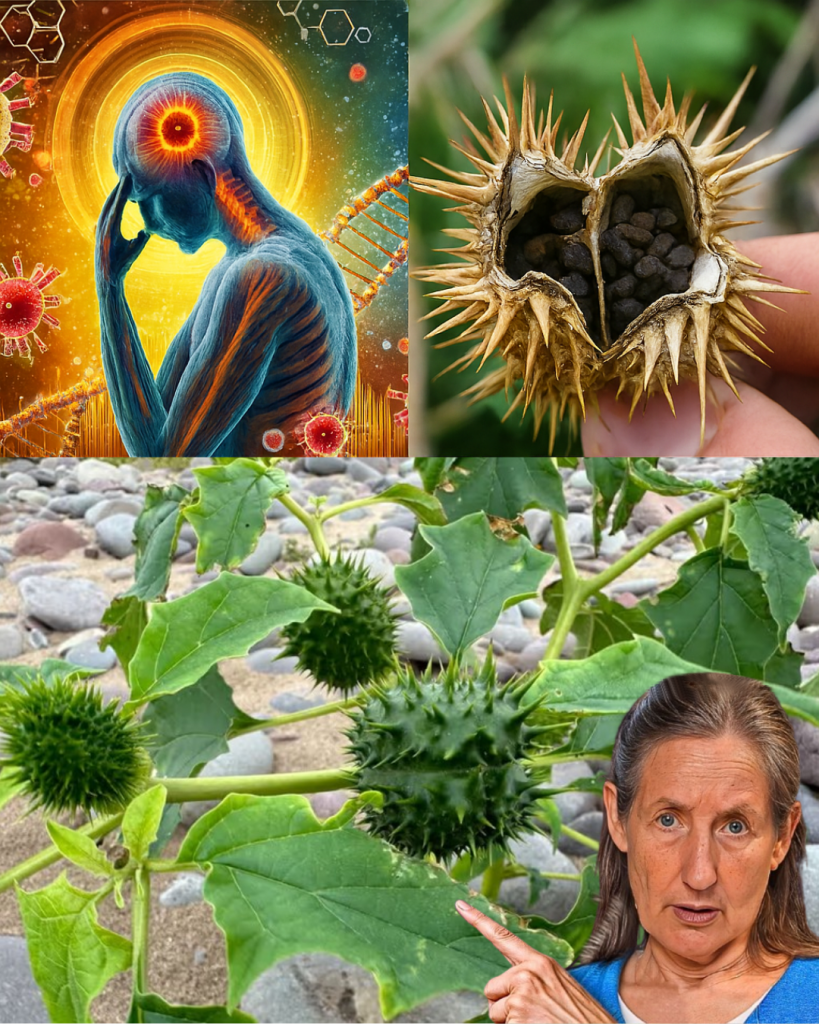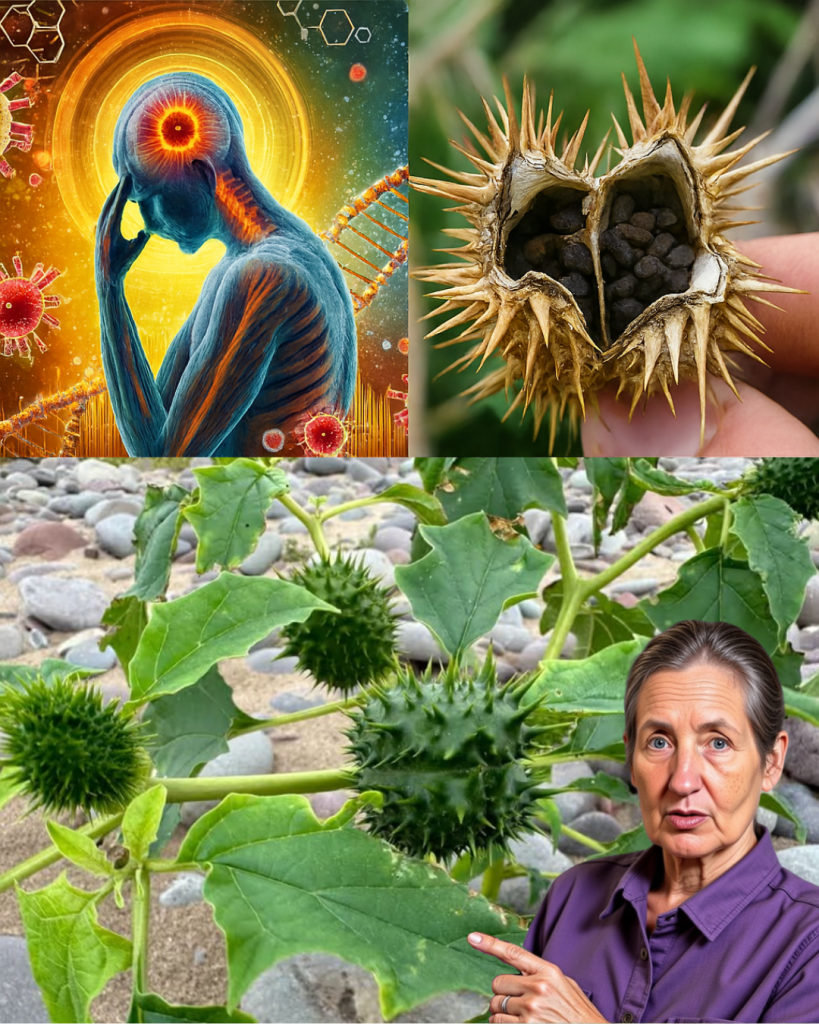It grows in your backyard, along quiet roadsides, and in forgotten corners of the world, its trumpet-shaped flowers glowing under the moonlight. Datura stramonium, known as thorn apple, jimsonweed, or devil’s trumpet, is a plant that captivates with its haunting beauty and sweet, heavy fragrance. But beneath its alluring exterior lies a dark and dangerous secret: every part of this plant is laced with potent toxins that can harm or even kill. For centuries, it’s been revered in folklore, used in ancient remedies, and feared for its deadly effects. What makes this plant so enchanting yet so perilous? Let’s unravel the mystery of Datura stramonium and explore why this stunning “weed” demands your respect and caution.

A Plant of Striking Beauty and Hidden Danger 🌿
Datura stramonium belongs to the nightshade family, alongside familiar plants like tomatoes and potatoes, but also the notorious deadly nightshade. Native to the Americas, it has spread across the globe, thriving in disturbed soils like roadsides, pastures, and abandoned lots. Its ability to flourish in harsh conditions makes it seem almost invincible, a silent invader in gardens and wild spaces alike.
What It Looks Like:
🌸 Height: Reaches up to 1.5–2 meters, standing tall and proud.
🍃 Leaves: Broad, dark green, with jagged, lobed edges that give it a wild, untamed look.
🌼 Flowers: Large, trumpet-shaped blooms, typically white or pale purple, that unfurl at night, exuding a sweet yet heavy scent.
🌰 Seed Pods: Spiny, oval capsules that burst open when mature, scattering tiny black seeds.
Its ethereal beauty draws the eye, but this plant’s true nature lies in its chemistry—a cocktail of toxins that makes it as dangerous as it is captivating.
The Toxic Power Within: Datura’s Deadly Chemistry 💀
Datura stramonium is loaded with potent alkaloids—chemical compounds that give it both its medicinal allure and its lethal edge. The primary culprits are:
⚗️ Atropine: Disrupts nerve signals, causing blurred vision, dry mouth, and rapid heartbeat.
⚗️ Scopolamine: Induces hallucinations, delirium, and in high doses, coma or death.
⚗️ Hyoscyamine: Affects the nervous system, leading to sedation or severe agitation.
These alkaloids block acetylcholine, a key neurotransmitter, wreaking havoc on the central and peripheral nervous systems. Even a small dose—whether from leaves, flowers, seeds, or roots—can trigger symptoms ranging from mild disorientation to life-threatening conditions. Ingesting just a few seeds can lead to:
🚨 Hallucinations and delirium
🚨 Rapid heartbeat and high blood pressure
🚨 Blurred vision and extreme dry mouth
🚨 Difficulty swallowing or breathing
🚨 In severe cases, coma or death
This plant doesn’t discriminate—humans, pets, and livestock are all at risk if they come into contact with it. Its beauty is a siren’s call, luring the curious into danger.
A Plant Steeped in History and Mystique 📜
Datura stramonium has woven itself into the fabric of human history, its dual nature as both healer and poisoner earning it a place in medicine, spirituality, and folklore. Ancient cultures across the Americas, Asia, and Europe used it with reverence and caution:
🩺 Medicinal Uses: In small, controlled doses, datura was used in traditional remedies to treat asthma, pain, or muscle spasms due to its sedative and antispasmodic properties.
🌌 Spiritual Rituals: Shamans and healers employed datura’s psychoactive effects for visions and spiritual journeys, though the line between enlightenment and danger was thin.
🧙♀️ Folklore: Known as “devil’s trumpet,” datura was linked to witchcraft and the supernatural, its hallucinogenic powers fueling tales of magic and mystery.
Today, its use in traditional medicine persists in some regions, but its risks far outweigh its benefits without expert supervision. Modern science studies datura for its alkaloids, exploring potential applications in pharmaceuticals, but its toxicity keeps it firmly in the realm of caution.
The Hidden Risks in Your Garden 🚫
Datura stramonium’s ornamental appeal makes it a tempting addition to gardens, with its striking flowers and spiky seed pods. But this beauty comes at a steep price. Its accessibility—growing wild or even cultivated—poses a significant risk, especially in households with children or pets.
Why It’s Dangerous:
🔴 Accidental Poisoning: Children may mistake its seeds or flowers for something edible, while pets can ingest it while exploring. Even handling the plant can cause skin irritation or transfer toxins to the mouth.
🔴 Recreational Misuse: Some seek datura for its hallucinogenic effects, unaware of the fine line between a “high” and a life-threatening overdose.
🔴 Widespread Growth: Its ability to thrive in diverse environments means it can appear unexpectedly in gardens, farms, or public spaces, increasing the risk of exposure.
Real-world cases highlight the danger: accidental poisonings have been reported from consuming datura seeds mistaken for edible plants or from teas brewed with its leaves. Symptoms can escalate rapidly, requiring immediate medical intervention.
How to Stay Safe Around Datura 🛡️
Datura stramonium’s beauty may tempt you, but its risks demand vigilance. Here’s how to protect yourself, your family, and your pets:
✅ Learn to Identify It: Familiarize yourself with datura’s trumpet-shaped flowers, spiky pods, and jagged leaves. If you spot it in your garden or nearby, treat it as a hazard.
✅ Avoid Planting It: Skip datura for ornamental gardening, especially if children or pets are present. Opt for safer alternatives like lavender or marigolds.
✅ Safe Removal: If you need to remove datura, wear gloves, long sleeves, and eye protection to avoid skin contact. Dispose of the plant securely in sealed bags to prevent accidental exposure.
✅ Educate Others: Warn family members, especially children, about the dangers of unknown plants. Teach them not to touch or ingest anything unfamiliar.
✅ Seek Immediate Help: If you suspect datura poisoning—symptoms include confusion, dilated pupils, or rapid heartbeat—call emergency services or a poison control center immediately. Quick action can be lifesaving.
Pro Tip: If you’re unsure whether a plant is datura, consult a local botanist or use a plant identification app before handling it.

Gardening Safely: Alternatives to Datura 🌼
Love the look of datura’s trumpet-shaped flowers but want to stay safe? Consider these non-toxic alternatives for your garden:
🌺 Angel’s Trumpet (Brugmansia): Offers similar stunning blooms but is less toxic when handled with care (though still not edible).
🌸 Morning Glory: Boasts vibrant, trumpet-like flowers without the dangerous alkaloids.
🌷 Trumpet Vine: A hardy, colorful option that’s safe for most gardens.
These plants deliver the aesthetic appeal without the deadly risks, making them ideal for family-friendly landscapes.
Why Datura Demands Respect 🌑
Datura stramonium is a plant of contradictions—its ethereal beauty and historical significance clash with its deadly potential. It’s a reminder of nature’s complexity, where allure and danger often coexist. Whether you encounter it in the wild, study its alkaloids for science, or hear its name in ancient tales, datura commands caution and respect. Its toxic nature underscores a vital lesson: not everything that grows is safe to touch or taste.
Before you plant or forage, research thoroughly. If datura is lurking in your garden, take swift action to remove it safely. By staying informed and vigilant, you can enjoy the beauty of nature without falling prey to its hidden dangers.
Call to Action: Have you spotted datura in your garden or neighborhood? Share your experience in the comments and help spread awareness about this deceptive plant!
Disclaimer: This article is for informational purposes only and does not substitute professional medical or botanical advice. Consult experts before handling unknown plants or if poisoning is suspected.









